Biology and Management of Biennial Wormwood (W1322)
The Glyphosate, Weeds, and Crops Series
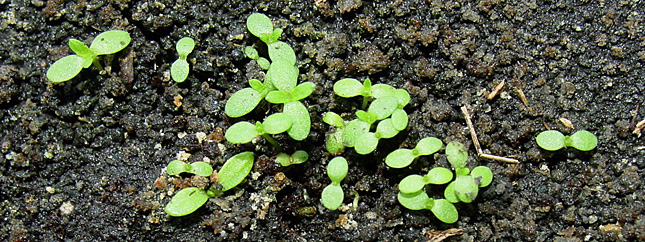
Figure 1. Biennial wormwood seedlings approximately seven days after emergence.
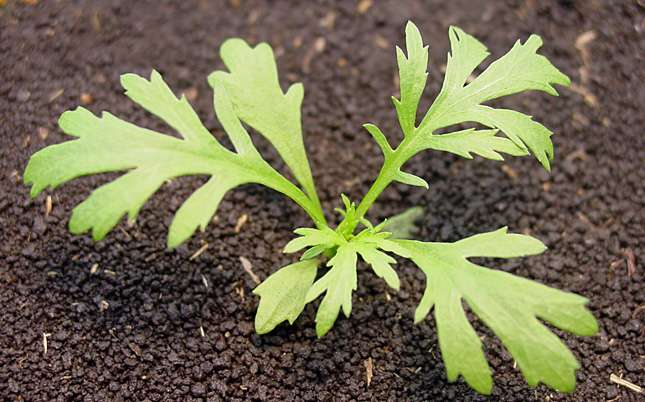
Figure 2. Biennial wormwood seedling approximately three to four weeks after emergence.
Identification
Biennial wormwood is a small-seeded plant that behaves like an annual species. Biennial wormwood stems arise from a tap root, are hairless and often are tinged red. The leaves are hairless and have toothed margins. Plants typically grow 3 to 7 feet (1 to 2 meters) tall with a woody stem averaging 1 to 2 inches (3 to 5 centimeters) in diameter. Biennial wormwood flowers consist of heads in clusters arranged in a spikelike form. Biennial wormwood is a prolific weed, producing approximately 1 million seeds per plant (Stevens 1932). Mahoney and Kegode (2004) later estimated that a single biennial wormwood plant produced 400,000 seeds. Stevens’ estimate of seed production possibly was from a biennial plant, whereas the later estimate was from an annual plant.
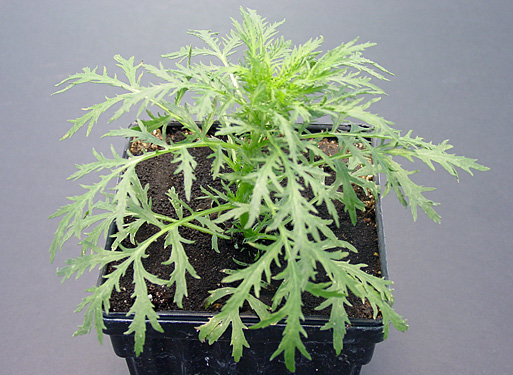
Figure 3. Bolting biennial wormwood plant.
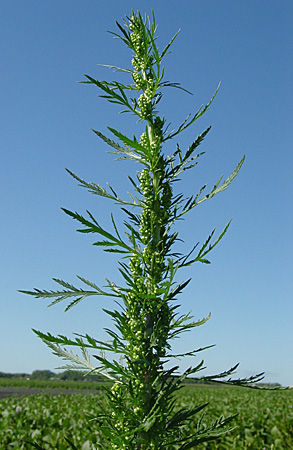
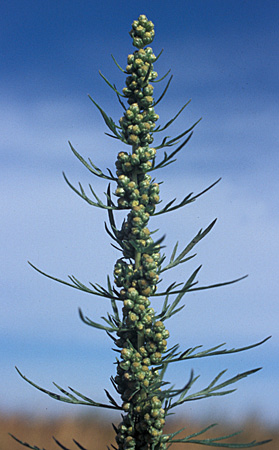
Figure 4. Photo showing spikelike flower head of a mature biennial wormwood plant in early September (left) and mid-October (right) at Fargo, N.D.
Occurrence and Distribution
Biennial wormwood is native to North America, specifically the Rocky Mountains and Sierra Nevada and Cascade ranges of the northwestern United States and western Canada.
Biennial wormwood historically was classified as a noncropland weed and, as such, did not receive much attention until cropland infestations began to rise noticeably. Surveys conducted in the late 1970s did not identify biennial wormwood in any field that was sampled (Dexter et al. 1981). However, in a 1997 survey of South Dakota, biennial wormwood was found in 92 percent of soybean fields (Snyder 1997), whereas in a 2000 survey, biennial wormwood was present in 3.2 percent of 663 North Dakota fields that were sampled (Zollinger et al. 2003). Similarly, biennial wormwood was not a common problem in continuous cereal and cereal-legume fields in Manitoba, Canada, in 1993 but was detected in 1994 (Ominski et al. 1999).
Biennial wormwood is found throughout the United States except the South (Figure 5). Perhaps annual and biennial types of biennial wormwood coexisted in the region of its origin, but primary use of the adjective “biennial” infers that the biennial trait was predominant. The eastward spread of biennial wormwood into agricultural areas may have resulted from selection of the annual biotype; however, this aspect of biennial wormwood has yet to be investigated.
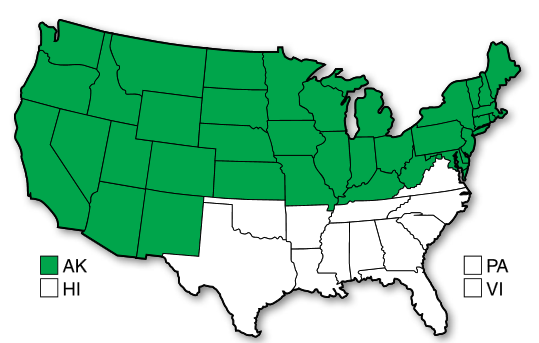
Figure 5. Distribution of biennial wormwood in the United States in 2000.
Seedling Emergence, Growth and Development
Seedling emergence can occur during the entire crop growing season under moist conditions and favorable environmental conditions. Characterization of emergence patterns in eastern North Dakota indicated that the weed began to emerge in late June or early July in corn, dry bean, soybean and sunflower (Kegode and Ciernia 2003). Biennial wormwood grows slowly after emergence, remaining as a rosette until midsummer, when plants bolt and growth becomes rapid. Biennial wormwood often is confused for common ragweed (Figure 6).
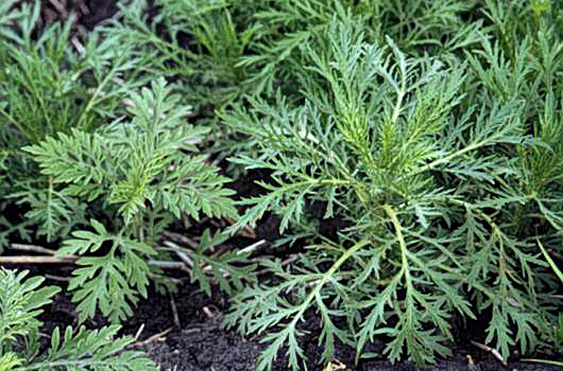
Figure 6. Comparison of biennial wormwood (right) and common ragweed (left) plants growing next to each other in the field.
Distinguishing Biennial Wormwood from Common Ragweed
Biennial wormwood can be distinguished from common ragweed by a close examination of the leaves. Biennial wormwood leaves have sharp edges and are hairless, whereas common ragweed leaves have smooth and round edges and are hairy (Figure 7).
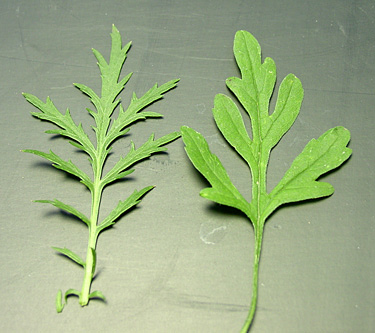
Figure 7. Comparison of leaves of biennial wormwood (left) and common ragweed (right).
Interference and Competition
Biennial wormwood emergence depends on soil type:
• In a silty clay soil, biennial wormwood emergence occurred in late June, compared with other common weed species, such as foxtail spp., common lambsquarter and pigweed spp., all of which emerge in late May or early June (Figure 8).
• In a sandy loam soil, biennial wormwood emergence occurred in late April (Fronning and Kegode 2004)
• In a loam soil, biennial wormwood emergence occurred in late May (Fronning and Kegode 2004).
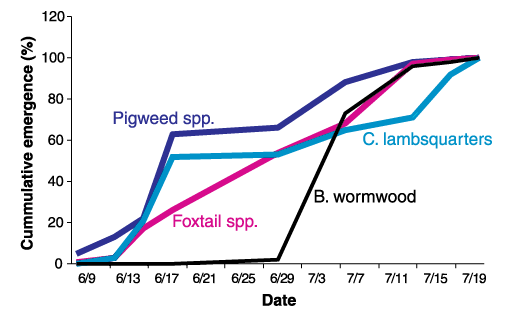
Figure 8. Cumulative emergence percentages for biennial wormwood, foxtail spp. (green and yellow), common lambsquarters and pigweed spp. (redroot and Powell amaranth) in soybean at Fargo, N.D. (silty clay soil) in 2003.
Upon emergence, biennial wormwood seedlings grow slowly and occur as rosettes for much of the early part of the growing season (Mahoney and Kegode 2004). In late July, when day length is declining, biennial wormwood plants bolt as they prepare to reproduce and appear above the canopy of crops such as soybean (Figures 4 and 9).
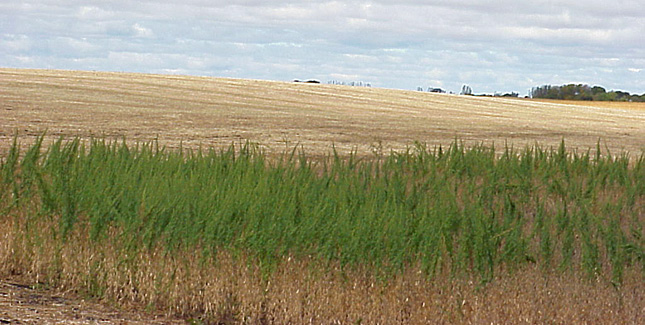
Figure 9. Unharvested section of a soybean field due to a biennial wormwood infestation.
Biennial wormwood competes more aggressively for resources than soybean, and season-long competition from nine biennial wormwood plants/yard2 (10 plants/meter2) can reduce soybean yield by 44 percent (Nelson 2001; Nelson and Kegode 2006). Further reductions in yield can occur as a result of harvesting inefficiency due to skips in soybean fields because farmers avoid large infestations of biennial wormwood (Figure 9).
Increased Prevalence
Misidentifying biennial wormwood as common ragweed; use of ineffective herbicides; multiple flushes during the summer; preference to moist, wet conditions; and survivability under most tillage systems have caused biennial wormwood infestations to increase.
Herbicide Tolerance
Biennial wormwood has natural tolerance to many soil-applied and postemergence broadleaf herbicides. Some herbicides include:
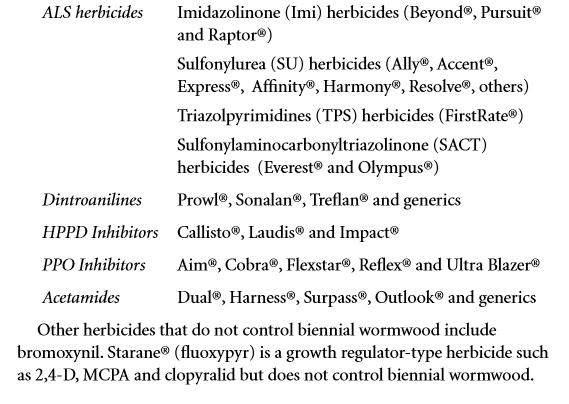
Control
Where possible, preemergence followed by postemergence herbicides is the most effective strategy in biennial wormwood control (Kegode 2000, Fronning and Kegode 2004b).
Preemergence
Because of season-long emergence of biennial wormwood, soil-applied herbicides with long residual are needed to provide the best management (Fronning and Kegode 2004a). Active ingredients of soil-applied herbicides that provide greater than 80 percent control of biennial wormwood include flumioxazin (Valor®), isoxaflutole (Balance®), metribuzin and sulfentrazone (Spartan® and Authority®). Biennial wormwood is tolerant of most ALS herbicide with the exception of flumetsulam (Python®). Flumetsulam applied pre-emergence will control biennial wormwood.
Postemergence
Postemergence herbicides must be applied to seedlings that are less than 3 inches (8 centimeters) in height (Fronning and Kegode 2004b). Biennial wormwood becomes very tolerant to postemergence herbicides when plants are greater than 3 inches tall. Active ingredients of postemergence herbicides that provide greater than 80 percent control of biennial wormwood include atrazine, bentazon, clopyralid, dicamba, glufosinate, glyphosate, MCPA and 2,4-D.

Biennial Wormwood Control in Other Crops
Drybean and Lentil
Apply Basagran® at 1 pint per acre (pt/A) before biennial wormwood seedlings are 2 to 3 inches tall, followed by another application of Basagran® at 1 pt/A no more than 14 days later. This sequential application results in excellent control of biennial wormwood. (Figure 10).
Dry pea and Chickpea
Apply Spartan® preemergence followed by post-applied Basagran®. A sequential postemergence Basagran® application can be used as described in the Drybean and Lentil section.
Sunflower – Conventional and Clearfield
Preemergence Spartan® may control or reduce biennial wormwood infestations.
Flax
Apply Spartan® preemergence followed by post-applied MCPA or Bronate®.
Canola and Sugarbeet
Apply Stinger® postemergence.
Potato
Preemergence Valor®/Chateau® can control or reduce biennial wormwood infestations.
Roundup Ready Alfalfa, Canola, Corn and Soybean
Glyphosate can control emerged biennial wormwood plants. Use of other effective residual herbicides may be needed for season-long control. See crop sections above. Glyphosate split-applied also provides excellent control of biennial wormwood.
Late Postemergence Control of Biennial Wormwood
Biennial wormwood can go undetected in crop fields until the seedlings are too large to be controlled effectively. Evaluation of Basagran®, Liberty® and glyphosate in greenhouse studies for efficacy of control of various sizes of biennial wormwood seedlings ranging from 2 to 19 inches (6 to 47 centimeters) indicated that:
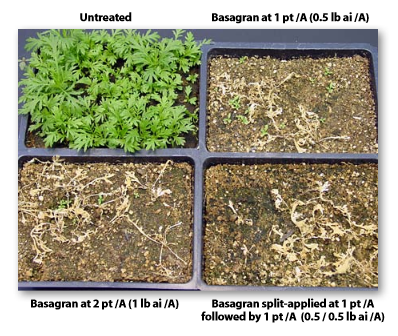
Figure 10. Control of biennial wormwood with Basagran® applied once and twice (split-application).
• Glyphosate applied at 0.75 and 1.5 pounds of acid equivalent per acre (lb ae/A) (1 to 2 quarts of 3 lb ae /gallon formulation) provided greater than 92 percent control of all sizes of biennial wormwood seedlings.
• Basagran® applied at 0.5 and 1 pound of active ingredient per acre (lb ai/A) (1 to 2 pints/acre) provided at least 80 percent control of biennial wormwood seedlings up to 8 inches (20 centimeters) tall.
• Liberty® applied in greenhouse conditions generally provided poor control regardless of biennial wormwood seedling size or herbicide rate (Kegode and Fronning 2005). However, several postemergence evaluations of Liberty applied in field conditions show excellent control.
Conclusion
Biennial wormwood is an established weed of the northern Great Plains, particularly in soybean, dry bean and sunflower. Because emergence is indeterminate, the best herbicidal control is from split applications of either Basagran® or glyphosate. The ultimate goal is to prevent biennial wormwood from producing seed since the plant is capable of producing up to 1 million seeds per plant. Late-season control is possible; however, only glyphosate will provide good to excellent control. Proper identification of emerged seedlings is important for choosing the best herbicide treatments for biennial wormwood control.
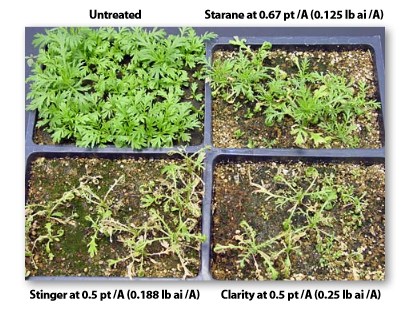
Figure 11. Control of biennial wormwood with Starane®, Stinger® and Clarity®.
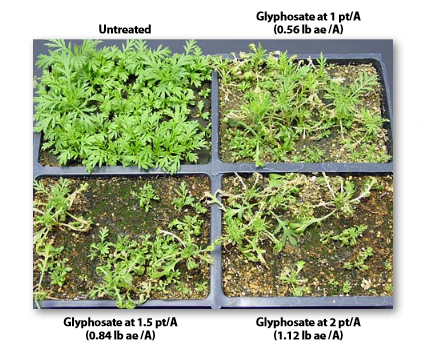
Figure 12. Control of biennial wormwood with glyphosate.
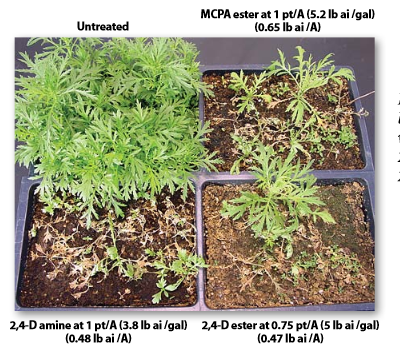
Figure 13. Control of biennial wormwood with MCPA ester, 2,4-D amine and 2,4-D ester.
References
Dexter, A.G., J.D. Nalewaja, D.D. Rasmusson and J. Buchli. 1981. Survey of wild oats and other weeds in North Dakota, 1978 and 1979. North Dakota State University Agricultural Experiment Station Research Report No. 79.
Fronning, B.E. and G.O. Kegode. 2004a. Biennial wormwood (Artemisia biennis) early-season control with herbicides. Weed Technology 18:611-618.
Fronning, B.E. and G.O. Kegode. 2004b. Biennial wormwood (Artemisia biennis) postemergence control in soybean. Weed Technology 18:380-387.
Kegode, G.O. 2000. Biennial wormwood (Artemisia biennis): An emerging weed problem in the Northern Great Plains. Abstract Weed Science Society of America 40:43.
Kegode, G.O. and M.G. Ciernia. 2003. Weed seedling emergence patterns in North Dakota row crops. Abstract North Central Weed Science Society 58:70.
Kegode, G.O. and Fronning, B.E. 2005. Late-season biennial wormwood (Artemisia biennis) control is influenced by plant size and weed flora at time of herbicide application. Crop Protection 24:915-920.
Mahoney, K.J. and G.O. Kegode. 2004. Biennial wormwood (Artemisia biennis) biomass allocation and seed production. Weed Science 52:246-254.
Neslon, E.A. 2001. Interference of biennial wormwood (Artemisia biennis Willd.) with soybean [Glycine max (L.) Merr.]. M.S. thesis. North Dakota State University, Fargo, N.D. 53 pp.
Nelson, E.A. and G.O. Kegode. 2006. Biennial wormwood (Artemisia biennis) competition with soybean (Glycine max). Phytoprotection 86:125-132.
Ominski, P.D., M.H. Entz and N. Kenkel. 1999. Weed suppression by Medicago sativa in subsequent cereal crops: a comparative survey. Weed Science 47:282-290.
Snyder, C. 1997. How to beat biennial wormwood. The Farmer/Dakota Farmer. March. p. 50.
Stevens, O.A. 1932. The number and weight of seeds produced by weeds. American Journal of Botany 19:784-794.
Zollinger, R.K., J.L. Ries and J.J. Hammond. 2003. Survey of Weeds in North Dakota 2000. North Dakota State University Agricultural Experiment Station Research Report No. ER-83, 97 p.
Zollinger, R.K. et al. 2006. North Dakota Weed Control Guide, Fargo, N.D., North Dakota State University Extension Service Publication W-253, 135 p.
Other Publications in this Series
To view other publications in the Glyphosate, Weeds, and Crops series.
Reviewed May 2013

